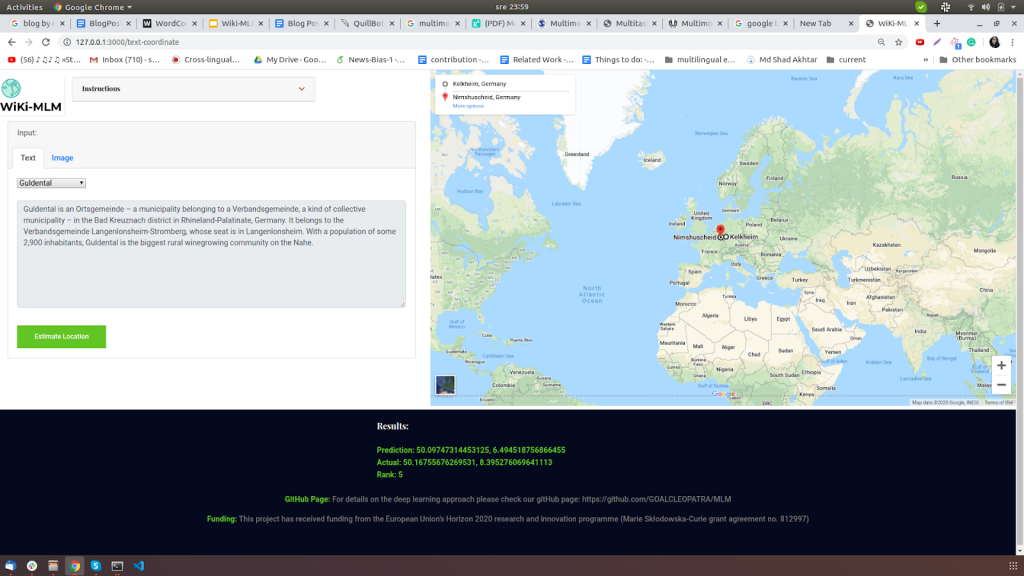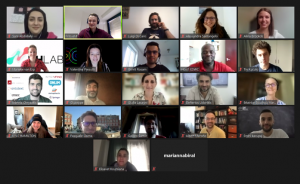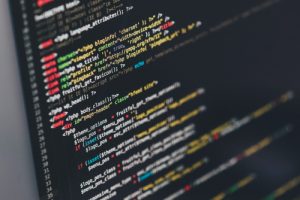This is the second of a series of blog posts discussing different aspects of the CLEOPATRA Research and Development week, which was held online at the end of March. The project ESRs organized themselves into groups to develop demonstrators, and this is the report from Team GOAL (Jason Armitage, Endri Kacupaj, Golsa Tahmasebzadeh and Swati Suman)
We’re a team of four researchers from different universities. We started working on MLM in December. Generating a publicly available, large-scale dataset to handle multiple modalities and languages is one of our core objectives. At the end of March, we had our first Hackathon Week for the Cleopatra project where we presented a pilot version of our demonstrator. We could say that it was a success!
Our Demonstrator revolves around MLM so, let’s check out what it’s all about.
What is MLM?
MLM is a Wikidata-generated dataset that is intended to train multitask systems. This system is anticipated to outperform single-task alternatives when simultaneously trained on task sequences. In our case, it is a system that performs both information retrieval and location estimation.
The dataset is composed of text, images, location data, and knowledge graph triples. We’re planning to release our dataset in two versions.
- The first version (MLM-v1) will contain texts with ~236k entities in three languages (English, German, and French)
- The second version (MLM-v2) will contain text with ~254k entities in ten different languages (English, German, French, Italian, Spanish, Polish, Romanian, Dutch, Hungarian, Portuguese).
Now, let’s find out why this idea for the demonstrator is worth pursuing.
Why MLM?
Systems trained on large datasets are believed to display rudimentary forms of the human ability to generalize. However, today’s systems struggle to deal with the diversity in real-world data and the ability to extend learning to new tasks.
MLM is a large-scale resource composed of different modalities and languages. It will offer the opportunity to train and evaluate multitasking systems. Such systems aim to reduce the application process complexity and boost generalization. At the same time, related applications will also benefit from machine learning models able to perform a number of independent tasks.
What did we do in the Hackathon?
Our final aim for the week was to create a live demo visualizing the results of the geo-location estimate of our models on maps. It was important because with just the raw latitude and longitude values it is hard to tell the quality of the output. For inference, we subdivided the surface of the earth into a number of geographic cells and trained a deep neural network with geo-tagged inputs that could be either text or image.
Visualizing results on Google Maps
Now, let’s see how our demo helps to visualize the output of the model’s location prediction.

What are our goals for the next demonstrator?
We are planning to build a multitask system capable of handling multi-objective tasks. We are intending to include some or all of the following tasks using the rich data provided by MLM:
- Given a news article,
- predict locations that conceptually resemble the news story. For this task, we aim to pinpoint the locations on the map with the highest conceptual similarity based on common KG entities in news reports.
- Given a location-based image and/or text, identify semantically similar
- locations and then link to a relevant news source to collect trending articles at that location;
- locations and places similar to that. Text and/or images will also be displayed based on user preference.
- Given a coordinate, identify
- semantically similar locations;
- textual description of the location;
- image(s) that best describes the locations;
- relevant news sources to collect trending articles at that location.
How do we collaborate as a team?
To keep track of our iterative progress towards well-defined goals, we conduct bi-weekly Scrum meetings and document our work. There we organize our ideas efficiently into sprint goals and we distribute the work among us. We even exchange our thoughts, challenges, and other information between the meetings.
Jason Armitage, Endri Kacupaj, Golsa Tahmasebzadeh and Swati Suman
 Like so many research projects since 2020, CLEOPATRA was significantly affected by the COVID-19 pandemic. Many of the planned events and meetings for the project had to be held online and there were fewer opportunities for the ESRs to get together in person. This made the final public workshop and business meeting organised in Hannover in May 2023 even more of an occasion. It was a chance for the whole CLEOPATRA team to come together as a group and celebrate the achievements of the ESRs over the lifetime of the project.
Like so many research projects since 2020, CLEOPATRA was significantly affected by the COVID-19 pandemic. Many of the planned events and meetings for the project had to be held online and there were fewer opportunities for the ESRs to get together in person. This made the final public workshop and business meeting organised in Hannover in May 2023 even more of an occasion. It was a chance for the whole CLEOPATRA team to come together as a group and celebrate the achievements of the ESRs over the lifetime of the project.
 The Cleopatra project promised to participate in the Networking Sessions of the ESWC (Extended Semantic Web Conference) each year of the project’s duration. The ESWC Networking S
The Cleopatra project promised to participate in the Networking Sessions of the ESWC (Extended Semantic Web Conference) each year of the project’s duration. The ESWC Networking S Despite the challenges of running an international research project during a period of restricted mobility and access, the CLEOPATRA project team have enjoyed some major successes over the last twelve months. Our fourteen Early Stage Researchers (ESR) have shown remarkable ability to adapt, innovate and collaborate. They have worked together online, across different countries and time zones, to build tools and design methods for studying the digital traces of major global events. In April 2020, a hackathon and Research & Development week were quickly reorganised to be delivered virtually. Working in teams, the ESRs developed demonstrators to address such questions as how to analyse online media over time and in multiple (often under-resourced) languages. There was further opportunity to work on the demonstrators, and to develop new research ideas, at a Learning week in June 2020, held in conjunction with the University of Amsterdam Digital Methods Summer School. In January 2021, the ESRs organised a second virtual hackathon and Research & Development week, which resulted in the publication of an updated Open Event Knowledge Graph (OEKG). The OEKG is one of the key resources developed by the project, and currently contains information about more than a million events in 15 European languages. This is a unique resource which will transform our understanding of how transitional social, cultural and political events play out online. All of these activities have led to the continuation and formation of new and promising research collaborations, which we hope to see bear fruit in the coming months.
Despite the challenges of running an international research project during a period of restricted mobility and access, the CLEOPATRA project team have enjoyed some major successes over the last twelve months. Our fourteen Early Stage Researchers (ESR) have shown remarkable ability to adapt, innovate and collaborate. They have worked together online, across different countries and time zones, to build tools and design methods for studying the digital traces of major global events. In April 2020, a hackathon and Research & Development week were quickly reorganised to be delivered virtually. Working in teams, the ESRs developed demonstrators to address such questions as how to analyse online media over time and in multiple (often under-resourced) languages. There was further opportunity to work on the demonstrators, and to develop new research ideas, at a Learning week in June 2020, held in conjunction with the University of Amsterdam Digital Methods Summer School. In January 2021, the ESRs organised a second virtual hackathon and Research & Development week, which resulted in the publication of an updated Open Event Knowledge Graph (OEKG). The OEKG is one of the key resources developed by the project, and currently contains information about more than a million events in 15 European languages. This is a unique resource which will transform our understanding of how transitional social, cultural and political events play out online. All of these activities have led to the continuation and formation of new and promising research collaborations, which we hope to see bear fruit in the coming months.

 One of the tasks of the CLEOPATRA project is to introduce early stage researchers (ESRs) to novel language technologies though secondment in industrial environments. For this purpose two ESRs from Zagreb University visited the
One of the tasks of the CLEOPATRA project is to introduce early stage researchers (ESRs) to novel language technologies though secondment in industrial environments. For this purpose two ESRs from Zagreb University visited the  Caio Mello’s secondment to the British Library, to work with the team at the
Caio Mello’s secondment to the British Library, to work with the team at the  Working in an interdisciplinary project is an effort as rewarding as it is challenging.
Working in an interdisciplinary project is an effort as rewarding as it is challenging.
 Group number 3, called MIDAS (Migrating Information from Different Annotated Sets), proposed uniting the functionalities of named entity recognition, sentiment analysis of citations, and event extraction under a single text annotation umbrella.
Group number 3, called MIDAS (Migrating Information from Different Annotated Sets), proposed uniting the functionalities of named entity recognition, sentiment analysis of citations, and event extraction under a single text annotation umbrella. We will be running our first international workshop on cross-lingual, event-centric open analytics at the 17th ESWC, which this year will be held in Heraklion, Greece, 31 May – 4 June 2020.
We will be running our first international workshop on cross-lingual, event-centric open analytics at the 17th ESWC, which this year will be held in Heraklion, Greece, 31 May – 4 June 2020.